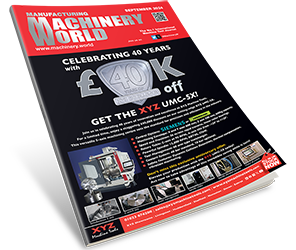Double disc fine grinding: The sharpening process is an important factor regarding the lifespan of the double disc grinding wheel.
A scientific study by Dr.-Ing. Marijke van der Meer (Krebs & Riedel Schleifscheibenfabrik GmbH & Co. KG) shows that by adjusting sharpening parameters such as pressure, speed, and grain size, the lifespan of double disc grinding wheels and sharpening tools can be significantly extended. This makes a standard sharpening process less advantageous and advocates for a targeted adjustment to the specific requirements of the tool. Technological consulting and optimization at the customer’s site can positively influence the cost-effectiveness and efficiency in double disc grinding with planetary kinematics
Conditions and Parameters during Sharpening:
A test machine from Mμtech, model AC500F, was used. This has been specifically adapted for Krebs & Riedel to accommodate smaller tool diameters to keep testing costs low. To ensure reproducible sharpening conditions, the wear of the sharpening ring is recorded, documented, and at least one repetition is performed. The coolant used is the emulsion Syntilo 81 E (5.4%). Sharpening rings are immersed or wetted in it, while no coolant is supplied during the sharpening process. Subsequently, the grinding wheels are cleaned.
In the standard sharpening procedure, one side is sharpened concavely and once convexly to keep the wheels straight. Only the rotation direction of the inner pin ring changes. The speeds in revolutions per minute (rpm) are: concave: ntop 30 / nbottom -36 / nmiddle -24 and convex: ntop 30 / nbottom -36 / nmiddle 24. The main load force is 38 daN, and the sharpening time per rotation direction is 25 seconds, with the first 5 seconds dedicated to wetting with coolant. Wear from both the sharpening ring and lower grinding wheel is recorded – the latter after both sharpening and grinding.
Initially, grinding wheels with specifications 4D 76 X 18 V8318-40 and closed layout are examined, which are sharpened with 57C 220 I 5 V59 (Figure 1). For dulling, components made from aluminum oxide ceramic (Figure 2) are processed. Here, nine components measuring 20 x 20 mm. from ALOTEC92 per carrier with five carriers correspond to a material layout of 22.4%. The main load speeds are ntop 200; nbottom -200; nmiddle 20 rpm with a starting grinding force in main load of 30 daN. The removal rate is set at 100 μm/min with an infeed per run of 200 μm. The grinding force increases automatically when dulling the grinding wheels to maintain removal rate. Runs continue until a maximum force of 250 daN is reached to ensure uniform dulling of the grinding surface.
In each trial, process cycle times, forces, actual removal rates, and wear on grinding wheels are documented. For aluminum oxide plates, roughness primarily arises from coarse material structure and is independent of sharpness level; thus, evaluation of component roughnesses is omitted here. Even with a dull tool, a Ra > 0.5 μm and Rz > 5 μm are achieved.
To capture sharpness levels under various process variations, a method using graphite imprints has been introduced. Holding devices for graphite pieces were created using 3D printing. These graphite pieces represent the produced envelope curve of grinding wheel topography as roughness when processed by upper and lower discs.
www.krebs-riedel.de







